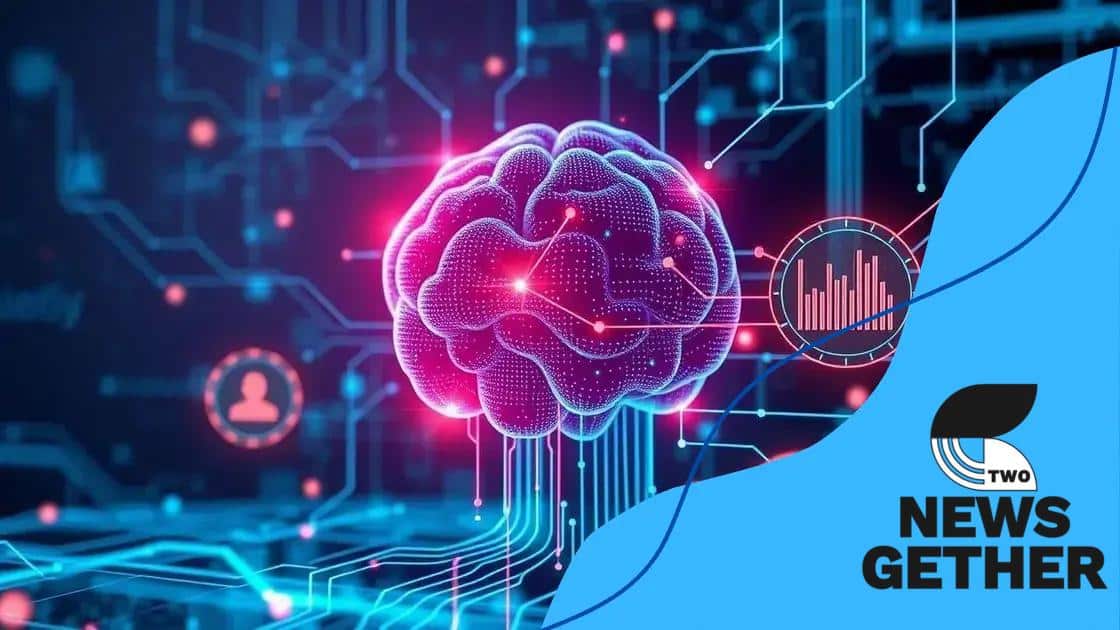AI’s role in combating misinformation and fake news

AI plays a crucial role in combating misinformation by automating fact-checking, personalizing information filtering, and enhancing verification processes, while addressing ethical concerns and the need for human oversight.
AI’s role in combating misinformation and fake news is more important than ever. As the digital age continues to grow, these technologies help us navigate a complex information landscape. How do they reshape our perception of truth? Let’s dive in.
Understanding the evolution of misinformation
Understanding the evolution of misinformation is essential in today’s digital world. Over the years, misinformation has transformed significantly, often spreading faster than the truth. In this article, we explore how misinformation began, how it evolved with technology, and where it stands now.
The Early Days of Misinformation
Misinformation isn’t a new issue; it’s been part of human communication for centuries. From rumors in local communities to sensational stories in newspapers, people have always shared information that isn’t entirely accurate. With the internet, especially social media, this problem escalated dramatically.
Technological Advancements and Misinformation
As technology advanced, so did the methods of spreading misinformation. Social media platforms became a hotbed for false information. This shift allowed misinformation to spread at an alarming rate. Algorithms on these platforms often amplify sensational content, making it more likely for users to encounter misleading information.
- Social media as a powerful tool for rapid dissemination
- Manipulative headlines that attract clicks
- The role of bots in spreading false narratives
- Influencers unwittingly sharing misinformation
Today, misinformation takes many forms, from fake news articles to deepfake videos that manipulate reality. This evolution challenges our ability to discern fact from fiction. As consumers of information, we must develop critical thinking skills.
The Current Landscape
Currently, misinformation presents a significant challenge for society. High-profile events, like elections and health crises, show how misinformation can sway public opinion and impact decision-making. During the COVID-19 pandemic, for instance, false claims about treatments and vaccines flooded social media platforms.
Understanding the evolution of misinformation helps us combat it effectively. We need to recognize the signs of misleading content and learn to verify information. Moreover, staying informed about the tools that AI provides can empower users to discern credible sources.
In conclusion, as misinformation continues to evolve, so must our strategies for combating it. Acknowledging its historical context allows us to appreciate the urgency of developing robust solutions to ensure our information landscape is more truthful and trustworthy.
How AI can fact-check in real-time
How AI can fact-check in real-time is a crucial aspect of battling misinformation today. With the rapid spread of information online, it’s more important than ever to ensure that what we read is accurate. AI offers innovative ways to verify facts quickly and effectively.
Real-Time Data Analysis
One of the ways AI can fact-check is through real-time data analysis. By continuously scanning content on the internet, AI algorithms can identify potential misinformation. This process happens in seconds, allowing users to receive instant feedback on the accuracy of information.
- AI tools can process large volumes of content.
- They analyze historical data to compare facts.
- These systems learn from new information to improve accuracy.
- Users can utilize browser extensions for immediate fact-checking.
As AI learns from past errors, it becomes better at detecting misleading claims. This continuous improvement allows AI to adapt to the evolving landscape of misinformation. By utilizing machine learning techniques, these systems can provide users with reliable information at a faster pace.
Combating Fake News
AI technologies also play a significant role in combating fake news. News outlets use AI to monitor their articles for inaccuracies before publication. By comparing stories against verified databases, they can flag potential issues.
These technologies can assist journalists by suggesting sources or previous articles that are relevant. This means that reporters can quickly access accurate information during their research process, leading to more trustworthy reporting.
Engagement and Alerts
Additionally, AI can engage users by alerting them to potential misinformation. For instance, when users search for certain topics, AI can provide warnings about unreliable sources. This proactive approach encourages users to think critically about the information they consume.
As we rely on AI to help us navigate the vast sea of information, understanding its capabilities will empower us to become more discerning consumers. Fact-checking in real-time is just one of the many tools available to help protect against misinformation. With continued advancements in AI, we can look forward to a future where accurate information is more accessible.
The impact of AI on public perception

The impact of AI on public perception is profound and multifaceted. As people consume more information online, AI tools shape how they understand and engage with various topics. With algorithms curating the content we see, the influence of AI extends far beyond simple automation.
Shaping Opinions
AI technology significantly shapes opinions by tailoring content to individual preferences. By analyzing users’ browsing habits, AI can recommend articles, videos, and posts that align with their interests. This targeted approach reinforces existing beliefs, creating echo chambers.
- A personalized feed leads to selective exposure.
- Users are often unaware of algorithmic influence.
- This can lead to polarization on critical issues.
- AI can exaggerate extreme viewpoints.
Such effects can distort public perception, skewing the understanding of complex matters. As individuals consume content that resonates with their views, they may become less open to alternative perspectives. Balancing personalized content and diverse viewpoints is crucial to fostering healthy discourse.
Influencing Trust
AI also plays a vital role in shaping trust in information. Advanced technologies, like deep learning, can generate realistic content—think of videos or news articles that look authentic but are fake. This phenomenon challenges the ability to discern fact from fiction.
As misinformation spreads rapidly, the public’s trust in sources can deteriorate. Users may find it increasingly difficult to identify credible information. Alongside this, legitimate organizations now employ AI-driven tools to flag false information or verify facts.
Engagement and Interaction
Engagement metrics often drive public perception as AI analyzes which content generates the most interaction. Stories that provoke strong reactions are prioritized, leading to sensationalism. People tend to engage more with shocking or emotionally charged stories, further shaping public narratives.
This cycle not only influences what people think but also how they feel about certain subjects. By adjusting the content’s visibility based on engagement, AI systems can inadvertently amplify misinformation. Therefore, understanding AI’s role in shaping public perception is essential as it directly affects societal views.
Challenges in using AI against misinformation
Challenges in using AI against misinformation are significant and complex. As the landscape of false information expands, so do the difficulties in developing effective AI solutions. These challenges can hinder the potential of AI in improving information accuracy.
Data Quality and Bias
One primary challenge is ensuring the quality of data used to train AI systems. AI relies heavily on data, and if that data contains biases or inaccuracies, it can lead to poor outcomes. For example, if an AI model is trained on biased datasets, it may inadvertently reinforce these biases, leading to misleading results.
- Biased data can skew fact-checking results.
- Inaccurate training data leads to flawed AI models.
- Ensuring data diversity is crucial for accuracy.
- AI may struggle to detect subtleties in misinformation.
These issues highlight the importance of using diverse, high-quality data while developing AI tools. Without this, the effectiveness of AI in combating misinformation could be severely compromised.
Rapid Information Flow
The rapid flow of information poses another challenge for AI systems. Misinformation can spread quickly across social media and other platforms, outpacing the speed at which AI tools can analyze content. This dynamic leaves little time for fact-checking and verification.
As new stories emerge and evolve, AI systems must constantly adapt to keep pace. Misinformation can change its form, often adapting to circumvent detection. For example, a false claim might take many variations, making it difficult for static AI models to catch them all.
Interpretation of Content
Understanding context is also a critical hurdle. Misinformation often relies on manipulative framing or selective presentation of facts. AI systems may struggle to interpret these nuances without human-like understanding.
The subtlety of language, especially sarcasm or humor, can complicate the detection of misinformation. As AI lacks the emotional intelligence of humans, it may misinterpret intent and context, which leads to errors in identifying false claims.
Ethical Concerns
Moreover, ethical concerns surround the deployment of AI for misinformation detection. Decisions about what content to flag or remove can raise questions about freedom of speech and censorship. Finding a balance between moderation and user rights is essential but challenging.
Thus, while AI has great potential to help combat misinformation, practical challenges remain. Overcoming these obstacles will require collaboration among technologists, ethicists, and policymakers.
Future trends in AI and information integrity
Future trends in AI and information integrity are crucial as technology continues to evolve. As we advance, the role of AI in ensuring that information remains accurate and reliable will only become more significant.
Enhanced Verification Tools
One trend we can expect is the development of enhanced verification tools. These tools will leverage advanced AI algorithms to automate the fact-checking process more efficiently. By using machine learning, AI can learn from previous inaccuracies to improve its ability to identify misleading information.
- Real-time verification processes will become more common.
- AI will analyze data sources rapidly for reliability.
- Integration of multiple fact-checking databases will aid accuracy.
- Visual recognition technology will help in detecting manipulated images and videos.
This evolution will help users quickly assess the integrity of information, shaping a healthier information ecosystem.
Personalized Information Filtering
Another trend is personalized information filtering. As AI technologies improve, they will provide users with more tailored content while also ensuring that they are exposed to diverse viewpoints. This balance is vital for preventing echo chambers and encouraging well-rounded perspectives.
AI can recommend verified content based on user interests while filtering out unreliable sources. By presenting users with multiple angles on a topic, it enables informed discussions.
Collaboration with Human Oversight
The future will also likely see collaboration between AI systems and human oversight. AI can identify inaccuracies and flag potentially misleading content, but human reviewers will still play an essential role in ensuring context and subtlety are considered.
This partnership aims to combine the rapid processing power of AI with the critical thinking skills of humans. By doing so, organizations can achieve a comprehensive understanding of content integrity.
Ethical AI Development
Finally, ethical AI development will take center stage. As concerns about privacy and data security rise, organizations will prioritize transparency in AI algorithms. Users will demand to know how their data is used and how information is filtered.
AI should be developed with ethical considerations in mind, focusing on accountability and fairness in the information provided. This focus will help build trust between technology developers and users.
Overall, as AI technology advances, so will the methods we use to ensure information integrity. These trends are vital for creating a more informed public and combating misinformation effectively.
FAQ – Frequently Asked Questions about AI’s Role in Combating Misinformation
How can AI help in fact-checking information?
AI can analyze vast amounts of data quickly, identifying potential misinformation and verifying facts in real-time.
What are the ethical concerns with using AI for information verification?
Ethical concerns include issues of censorship, transparency about data use, and ensuring that AI doesn’t reinforce biases.
How does AI personalize content for users?
AI algorithms analyze user behavior and preferences to recommend tailored content, while aiming to expose users to diverse viewpoints.
What are future trends in AI related to information integrity?
Future trends include enhanced verification tools, better collaboration with human reviewers, and a focus on ethical development in AI.






